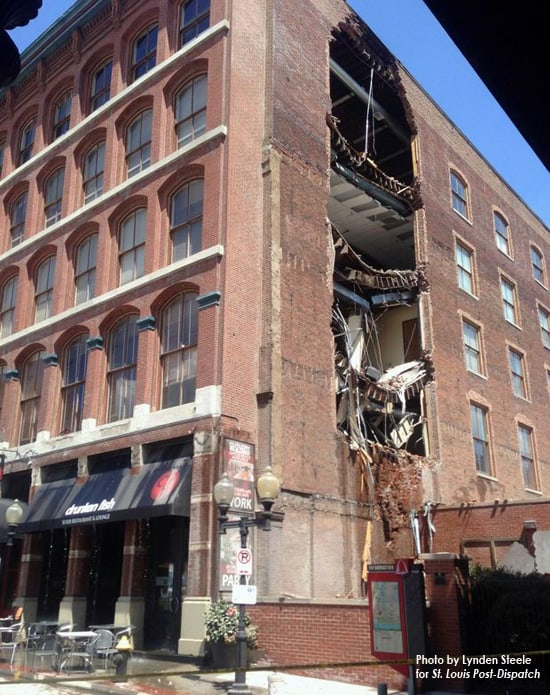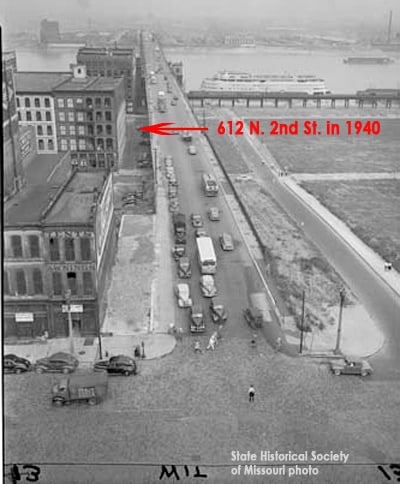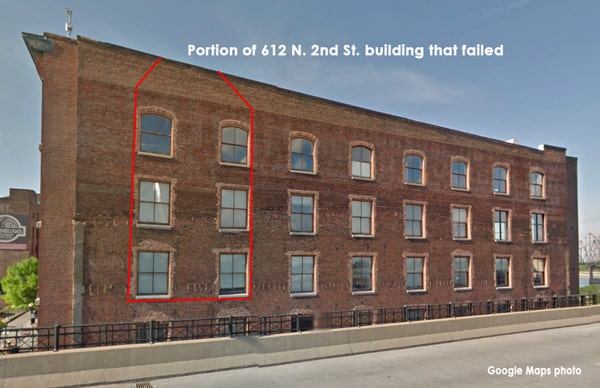On August 12, 2015, a section of the brick wall on a building erected in 1860 failed dramatically, leaving a 5-story gaping hole on the south side of the historic building. All occupants escaped without injury. Here’s the original news story about the Laclede’s Landing building collapse.
The owner of the building at 612 North Second Street, also known as the Cutler Factory, will repair the occupied building, and the cause of the brick failure is still being investigated. In the meantime, Fox2 News called upon a building scientist and remodeling expert, Scott Mosby, to share what he knows about what can cause a brick wall to collapse.
612 North Second Street Background
The Cutler Factory was erected in 1860 of unreinforced masonry construction, which was common building practice for that time period. Steel reinforced construction was a brand new concept that people were hesitant to use, and were still suspicious of when the nation’s first steel structure bridge began construction right next door to the Cutler Factory in 1868. This would be Eads Bridge, which was completed and opened for use in 1874.
It has been noted that the southern wall of 612 North Second Street shows hand-packed masonry work that was typical for an interior wall. Walls to be seen by the public (like the front and rear facade of 612) have a much neater and more durable masonry finish, whereas this wall was never intended to be seen because another building was planned to be attached.
While we await final confirmation from architectural historians with access to early Laclede’s Landing facts, there is the photo above from the State Historical Society of Missouri. It depicts the Eads Bridge in 1940, at the approach from Washington Avenue. The red arrow points to 612 North Second Street.
The southern-facing brick wall has no windows, and displays a “scar” of what may have been a 4-story structure connected to 612. The construction of Eads Bridge may have brought about a quick demise of the building, as it was directly in the path of construction (which is what appears to have happened to all the buildings shown in this photos foreground).
Regardless of when that brick wall was exposed, the simple act of exposure did not create a structural problem. The wall stood for 155 years without incident.
Modern Life Weighs Upon the Building
By the 1970s, Eads Bridge was virtually dormant with no train or vehicle traffic. This would have greatly reduced the amount of seismic vibration for all of the nearby brick buildings.
In 1985 windows were installed in the southern brick wall for the very first time. What is not known is if, in subsequent decades, there were any water leak issues around the 32 windows.
In 1993, Eads Bridge came back to life as host to the new St. Louis Metro Link light rail line and vehicle traffic on the top deck. This would be greatly increased seismic activity since the neighboring wall was renovated 12 years before.
Ongoing investigations will pinpoint exactly what series of occurrences triggered the partial collapse. The photo above shows the area of the building that went down, similar to dominoes falling. The failure may have happened suddenly and dramatically, but there would have been signs beforehand that something was not quite as right as it could have been.
Buildings constantly reveal clues about their condition; this is how we know when they need repair or maintenance. Sometimes the clue is easy to understand, like an overflowing gutter means the gutters need to be cleaned out. Other times, an outward clue only appears to the untrained eye after the internal problem had gone unattended for too long.
When a dramatic problem like a wall collapse occurs, the media calls upon building scientists like Scott Mosby for a quick lesson about what may have gone wrong. But before this kind of problem happens, know that Mosby Building Arts can inspect and evaluate your home to learn how safe and sound it may – or may not – be.
Mosby Home Consultants understand all ages and types of buildings, from assessing and correcting structural problems to finding and solving reoccurring water leaks. Have them evaluate your home to learn about potential weaknesses or problems before they manifest, as well as properly diagnose existing issues so it can be fixed right the first time.
For a thorough home evaluation, call the Mosby office at 314.909.1800 or contact them here.







